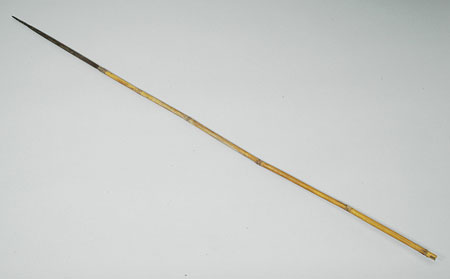Accession Number:
1944.10.43
Country:
Sudan
Region:
Blue Nile ?Darfung
Cultural Group:
?Burun
Date Made:
By 1912
Materials:
Cane Plant , Ebony Wood Plant , Animal Hide Skin
Process:
Carved , Notched , Socketed , Bound , Decorated
Dimensions:
Total L = 1036; arrowhead L = 285, diam = 9.2; shaft L = 751, diam = 9.5 x 9, L nock = 10, L binding = 24 mm [RTS 25/5/2005].
Weight:
38.7 g
Other Owners:
L. Gorringe and Mrs L. Gorringe
Field Collector:
L. Gorringe
PRM Source:
Mrs L. Gorringe
Acquired:
Donated October 1944
Collected Date:
1902 - 1912
Description:
Arrow consisting of a dark brown ebony arrowhead (Pantone black 4C) with a narrow body that tapers out slightly along its length before narrowing again at its base.
The upper body has been decorated with a row of 3 horizontal notches down either side, just below the tip, then 2 further pairs of notches, the upper set at right angles to the others.
There are shaving marks visible down the body, which also shows traces of polish.
The base of the tang has been fitted into the socketed top of a yellow cane shaft with 6 segments along its length and a slightly oval section (Pantone 7509C).
The surface of the shaft is smooth, and the junction of tang and shaft has been bound round with narrow strips of animal hide to prevent the wood splitting on impact.
This is a grayish brown colour (Pantone Warm Gray 10C).
There is usually a second bound area just above the butt end on arrows of this type, but in this instance the binding has been lost.
The butt is nocked, with 2 rectangular notches cut into opposite sides.
The arrow is complete, except for the missing binding; The lower part of the shaft has split in several places.
It has a weight of 38.7 grams and a total length of 1036 mm.
The visible area of the arrowhead has a length of 285 mm and a diameter of 9.2 mm, while the wooden shaft is 751 mm long, with a diameter of 9.5 by 9 mm and a nock length of 10 mm; the binding is 24 mm long.
Collected by L. Gorringe at some time between 1902 and 1912, possibly from Darfung, and donated to the Pitt Rivers Museum by his wife, Mrs L. Gorringe.
For a group of bows collected by Gorringe, and possibly from the Burun, see 1944.10.28-34; for additional Burun arrows, see 1944.10.34-71.
Rachael Sparks 29/8/2005.
Collected by L. Gorringe at some time between 1902 and 1912, possibly from Darfung, and donated to the Pitt Rivers Museum by his wife, Mrs L. Gorringe.
For a group of bows collected by Gorringe, and possibly from the Burun, see 1944.10.28-34; for additional Burun arrows, see 1944.10.34-71.
Rachael Sparks 29/8/2005.
Primary Documentation:
Accession Book Entry
[p.
375] -
Mrs L.
GORRINGE, Rosaries Farm, Ngong, Kenya
.
Specimens collected by her late husband, Captain L.
Gorringe, M.C., in the ANGLO-EGYPTIAN SUDAN between 1902 and 1912.
Undocumented.
[p.
383] 1944.10.34-71 - [1 of ] Thirty-eight arrows, all of the same type: cane shafts deeply notched, not feathered, the heads ebony spikes tanged into the shaft and tapering to the point.
Above the notch, which is almost immediately below a joint in the cane, and at the opposite end where the head is inserted, the shafts are bound with a narrow strip of thin membrane.
The ebony heads are round in section and varying in length, the extremes being, from above the shaft binding to the tip, 4 1/4" (with long shaft) and 24 5/8" (with short shaft); all are carved towards the tip end, either with an all-over criss-cross pattern more or less shallowly incised, or with two rows of oblique notches cut alternately on the two sides of the point so as to give it a spiral turn.
In a few specimens the shaft is incised in various patterns (owner’s marks?).
Lengths varying between 3' 6 3/4" and 3' 1".
Same data [Probably the BURUN of DAR FUNG].
(In some specimens the tips of the ebony heads are broken or the shaft bindings loose or missing).
Added Accession Book Entry [p. 382] - A21.F16.17-18 [red biro].
Card Catalogue Entry - There is no further information on the object catalogue cards ['Weapons - offensive - Archery - Arrows' RTS 23/7/2004].
Pitt Rivers Museum label - AFRICA, Sudan. Probably Burun tribe of Darfung. Cane arrow with ebony point. Don. Mrs L. Gorringe. 1944.10.43 [plastic label, tied to object; RTS 25/5/2005].
Written on object - BURUN, DAR FUNG, A.-E. SUDAN. 1944.10.43 [RTS 24/5/2005].
Added Accession Book Entry [p. 382] - A21.F16.17-18 [red biro].
Card Catalogue Entry - There is no further information on the object catalogue cards ['Weapons - offensive - Archery - Arrows' RTS 23/7/2004].
Pitt Rivers Museum label - AFRICA, Sudan. Probably Burun tribe of Darfung. Cane arrow with ebony point. Don. Mrs L. Gorringe. 1944.10.43 [plastic label, tied to object; RTS 25/5/2005].
Written on object - BURUN, DAR FUNG, A.-E. SUDAN. 1944.10.43 [RTS 24/5/2005].






